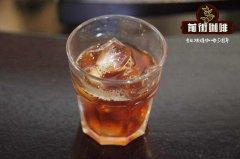How to drink Cuban coffee beans Cuban coffee powder What are the characteristics of Cuban coffee

Professional coffee knowledge exchange more coffee bean information please follow the coffee workshop (Wechat official account cafe_style)
Cuba is familiar with distant countries, familiar with the Cuban baseball team often win baseball world championships at all levels, far away is Cuba on the other side of the world in the beautiful Caribbean, coffee and other Cuban industries are state production and management, Cuban coffee is best produced in the Central Mountains region (Escambray), the Central Mountains area in addition to coffee there is quartz? Crystal and other precious minerals are produced, so the Central Mountain region (Escambray) is also known as Crystal Mountain. The production of Cuban Crystal Mountain Coffee is rarely monopolized by Japan's Meiwa and France's Cafe Legal Coffee Company. Cuban Crystal Mountain Coffee is a typical island bean with a clean and delicate taste, slightly sour not strong but long-lasting, with a sweet fruit flavor in the finish.
Cuba, located in the Caribbean, is an island country under communist rule, and its capital is Havana. Cuba is famous not only for its snow-white beaches and cigar tobacco, but also for its excellent coffee. Cuba has a long history of growing coffee, and Jos é Antonio Gelabert introduced the first coffee factory to Cuba in 1748. In 1791, when slavery was abolished during the Haitian revolution, French colonists fled to Cuba, bringing better methods of coffee production to Cuba. Before the era of Castro, Cuba's coffee industry boomed, and coffee beans were once Cuba's number one export, with more "sugar" than life's necessities. In the mid-1950s, Cuba exported more than 20000 metric tons (22046 short tons) of coffee beans a year, all of which were sold at high prices, with most of the coffee exported to Europe, especially the Netherlands and Germany. In the late 19th century, the price of local coffee plummeted because of government policies and the chaos of the international political situation, so farmers turned to plant other crops.
The planting area of Cuban coffee is divided into three parts, which are planted on the slopes and valleys above sea level from 1000 to 2000 meters above sea level, with the largest proportion of Santiago de Cuba and Granma in the east accounting for 70% of the whole country, followed by the central villa Clara and Sancti Spiritus accounting for 20%, and the western Pinar del Rio accounting for 10%. These areas provide a quite comfortable growing environment for coffee beans, with an average temperature of 21 degrees in winter and 25 degrees in summer. The rainfall is moderate, the humidity is evenly distributed all the year round, and the soil is deep and fertile. All planted Arabica (Arabica) varieties, to Tibica (Typica). In 2000, the United Nations Educational, Scientific and Cultural Organization (UNESCO) listed two coffee producing areas, Santiago and Guantanamo, as World Heritage sites.
Cuban small crystal, the color of raw coffee beans is more yellow, the beans are slightly smaller than those in the Caribbean, the natural washing method is adopted, and the coffee beans are dried by the sun in the latter section, with fewer defective beans and empty shell beans, and the moisture content of coffee beans is high.
Shallow roasting City (fragrance): when injected with water, coffee powder and hot water produce a strong sweetness of honey, soft taste with a little mint refreshing, wheat aroma will not feel uncomfortable (Kaka), coffee aftertaste in the middle of the tongue like mint gum across the refreshing, this is a good sour coffee without killing breath.
Important Notice :
前街咖啡 FrontStreet Coffee has moved to new addredd:
FrontStreet Coffee Address: 315,Donghua East Road,GuangZhou
Tel:020 38364473
- Prev

Shallow roasting coffee beans how to freshly roast coffee beans
Professional coffee knowledge exchange more coffee bean information Please pay attention to the coffee workshop (Wechat official account cafe_style) the degree of roasting of coffee depends on the color of its appearance: light, medium or dark, although this is not the most accurate method to judge the roasting degree. Some coffees are naturally darker or lighter than others, but it is still the most convenient way to judge roasting degree. Choose and buy coffee
- Next

Colombian Coffee understands the Flavor and introduces the Origin of Camasuna Coffee Bean
Professional coffee knowledge exchange more coffee bean information please follow the coffee workshop (Wechat official account cafe_style) Colombian coffee-produced in Colombia, roasted coffee beans will release sweet aroma, with sweet in the acid, bitter in the good quality characteristics, because of the appropriate concentration, it is often used in high-grade mixed coffee. Colombia
Related
- Beginners will see the "Coffee pull flower" guide!
- What is the difference between ice blog purified milk and ordinary milk coffee?
- Why is the Philippines the largest producer of crops in Liberia?
- For coffee extraction, should the fine powder be retained?
- How does extracted espresso fill pressed powder? How much strength does it take to press the powder?
- How to make jasmine cold extract coffee? Is the jasmine + latte good?
- Will this little toy really make the coffee taste better? How does Lily Drip affect coffee extraction?
- Will the action of slapping the filter cup also affect coffee extraction?
- What's the difference between powder-to-water ratio and powder-to-liquid ratio?
- What is the Ethiopian local species? What does it have to do with Heirloom native species?

